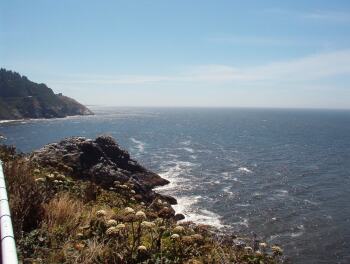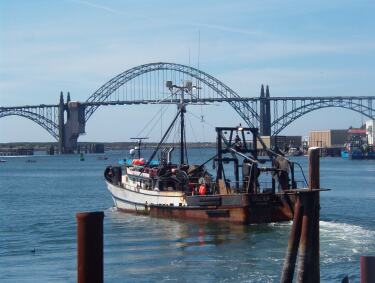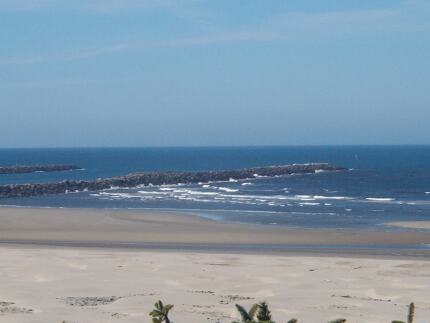
Publisher:
Bonnie King
CONTACT:
Newsroom@Salem-news.com
Advertising:
Adsales@Salem-news.com

~Truth~
~Justice~
~Peace~
TJP
Aug-16-2006 22:37

 TweetFollow @OregonNews
TweetFollow @OregonNews
Scientists: Oregon’s Ocean Upwelling Fueled by Jet Stream, Sub-Arctic and River Flow
Salem-News.comThe Coastal Ocean Advances in Shelf Transport program, or COAST, was led by researchers at Oregon State University.
 Photos by: Kevin Hays |
(CORVALLIS) - A team of nearly 60 scientists, have wrapped up a five-year study of the ocean circulation, biology and chemistry off the Oregon coast, has discovered a new cycle of activity in the Jet Stream that has a major influence on upwelling and ocean productivity.
Funded by the National Science Foundation, the study also found that Oregon has a unique upwelling system with processes that can reduce the level of atmospheric carbon dioxide. However, when those same processes are altered by changes in atmospheric or oceanic conditions, the result can be the onset of hypoxia, or oxygen-starved water that leads to marine die-offs and “dead zones” in the ocean.
“One of the things we’ve discovered is a new time scale of atmospheric activity somewhere between the weather bands that change every 2-5 days and the summer-winter seasonal adjustments,” said Jack Barth, a professor in OSU’s College of Oceanic and Atmospheric Sciences and a principal investigator on the project.
“It seems that every 30 days or so, the Jet Stream ‘wobbles’ and it changes the entire pattern of winds and the ocean’s response to them,” Barth said. “The central Oregon coast is affected by weather systems tracking along the Jet Stream, and when it moves to the north, we tend to get good upwelling. When it moves to the south, the upwelling goes bad.”

In 2005, Barth said, the Jet Stream migrated southward and caused a delay in the upwelling, leading to unusual ocean conditions. These “wobbles” in the Jet Stream change the ocean temperature, can accelerate or reduce upwelling and nutrient-enrichment, and ultimately affect the production of phytoplankton, which feed the marine food web.
What causes these changes in the Jet Stream isn’t fully understood, the OSU researchers say. One strong influence on the Jet Stream is the enormous mountains in Asia.
The Heceta Bank off the coast between Newport and Florence exerts a major influence on Oregon’s coastal ocean. It protrudes into the Pacific Ocean and deflects the north-south currents, creating a quiet area that serves as a natural incubator for plankton. Slight shifts in the winds, however, could lead to overproduction and hypoxia, or on the other hand, insufficient upwelling to feed the food chain.
Not coincidentally, the part of the northeast Pacific Ocean most affected by dead zones has been the central Oregon coast.
Further complicating the upwelling picture, the researchers discovered, is the influence of sub-Arctic waters that flow south into the near-shore region off Oregon. The OSU scientists monitored these waters over the past five years and discovered some interesting variations, said Pat Wheeler, an Oregon State oceanographer and a principal investigator on the study.

“In 2002, for example, there were a number of storms in the Gulf of Alaska and the flow of sub-Arctic water down our coastline was highly elevated in nutrients,” Wheeler said. “That led to a four-fold increase in phytoplankton production that year and after they fell to the seafloor, bacterial degradation sucked all of the oxygen out of the water. That was the first year that scientists began observing and monitoring a string of hypoxia events leading to ‘dead zones.’”
Wheeler and her colleagues also measured the influence of Oregon’s small coastal rivers on nutrients in the coastal zone. They discovered that Oregon’s rainfall ultimately feeds nutrients into the ocean by elevating these small coastal rivers and naturally leaching iron from the rocks in the streams.
“The iron that is deposited into the waters offshore actually helps fertilize the waters and promotes biological activity months later,” she said. In contrast, the waters off California have limited iron, the researchers say, because there aren’t as many coastal rivers pumping fresh water into the ocean.
The COAST program was funded through a $9 million grant from the NSF and drew experts in ocean biology, chemistry and physics from OSU, the University of North Carolina, Lamont-Doherty Earth Observatory, and the Woods Hole Oceanographic Institution. One focus of their research was the study of east-west movement of water.
While the north-south currents are widely known, less is understand about the mechanisms that move water from Oregon’s coast line to deeper water and vice versa, the researchers said. During the COAST project, they were able to observe how phytoplankton decomposed, fell to the ocean floor, and were swept out to the deep ocean by water moving in a westerly direction.
That process also serves to lower atmospheric carbon dioxide, which the plankton draw down and use to bloom, by depositing it into the deep ocean.
“When decomposing phytoplankton are respired over the shelf, instead of being transported offshore, we get low oxygen conditions, or hypoxia,” Barth said. “And the CO2 can go right back into the atmosphere. But when the system works, and the phytoplankton take the carbon dioxide into the deep ocean, it makes the central Oregon coast a net sink for atmospheric CO2.”
Using their expanded knowledge and an emerging ocean observing network to develop predictive models is the next phase of the research, the OSU scientists say.
Articles for August 15, 2006 | Articles for August 16, 2006 | Articles for August 17, 2006



Salem-News.com:


Terms of Service | Privacy Policy
All comments and messages are approved by people and self promotional links or unacceptable comments are denied.
[Return to Top]
©2025 Salem-News.com. All opinions expressed in this article are those of the author and do not necessarily reflect those of Salem-News.com.